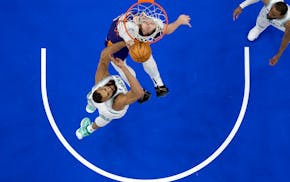Following his dramatic victory Saturday in Skateboard Big Air, Elliot Sloan felt a pain in his abdomen. Maybe it was anxiety, he thought; it had been a stressful week of preparation for the X Games, and the competition at U.S. Bank Stadium had been fierce.
Or it might have been the hard fall he took minutes earlier, when he crash-landed on an unforgiving plywood ramp when a trick went haywire, falling right on his posterior.
"Those ones hurt real bad," Sloan said. "It feels like everything just exploded in this area."
Sloan rubbed his stomach, right underneath a gold medal the size of a dessert plate. Like most X Games athletes, he accepts concussions, broken bones, abrasions, dislocations and throbbing innards as occupational hazards. When your credo is 'go big or go home,' you sometimes require a side trip to the emergency room.
After his crash, Sloan received medical attention and limped gingerly off the course. Less than half an hour later, he barreled down a 65-foot ramp, spun two times as he flew over a 65-foot gap, rolled up a steep quarterpipe and soared nearly 48 feet off the ground. This time, he completed the trick that failed earlier — a tailgrab 900, a 2 ½-revolution spin while grabbing the back of the board — and landed it perfectly to earn 91.66 points and the gold.
"It takes a second to evaluate what's going on and how bad it is," said Sloan, who won his 11th X Games medal. "Usually, the sting kind of wears off, and it's like, 'All right.' Now, I'm kind of feeling something in my stomach.
"I've been competing more than 10 years. And to me, [shaking off falls] has always been one of the toughest things."
That kind of resilience is a big part of the X Games, where the spills are as breathtaking — and nearly as plentiful — as the thrills. Saturday, several riders in BMX Dirt crashed hard and got up slowly; Andy Buckworth of Australia was helped off the course and could not continue. Gasp-inducing falls in skateboarding and Moto X showed why a first-aid products company is among the X Games sponsors.
Though many events fall under the category of "don't try this at home," several athletes emphasized they don't approach these death-defying sports with a cavalier attitude. Ryan Williams, the gold medalist in BMX Big Air, said riders take months to develop new tricks. When they begin trying them out, they use safety devices such as foam pits or airbags.
By the time those tricks show up in competition, Williams said, he could do them with his eyes closed. He was quick to point out that he would never actually do such a thing; that would be reckless, after all.
"A lot of people see action sports as daredevils. They think we don't care if we get hurt," Williams said. "Actually, everything here at X Games is so calculated. We're not just sending ourselves across a 50-foot megaramp and hoping we're going to land on our wheels. We've done the work."
Kyle Baldock, a 10-time X Games medalist in BMX, said improvements in safety equipment have led to bigger and better tricks. When he was young, he and his friends would drag an old mattress to the skate park to break their falls. Now, safety aids are so advanced that Baldock — who said he has broken 27 bones — can perfect "massive" tricks he could only dream of seven years ago.
Some of the most massive come in Moto X, where 250-pound motorcycles make the high-flying stunts even more dangerous. David Rinaldo, who won Moto X Best Trick, broke his ankle in a crash just after he was invited to the X Games. Saturday, he had been back on the bike for only a week, but he still debuted a spectacular spinning backflip.
"Freestyle motocross is my life," Rinaldo said. "We don't really deal with [the danger]. We just go. It's just passion."
And sometimes, there's a little behind-the-scenes help. After Sloan's Big Air victory, he dropped his trousers to show off his new, custom-made hip pads, which might have spared him more serious injury Saturday.
"This one saved me," he said, pointing to a pad on his tailbone. "Thank God I had it."

Reusse: How bad are the White Sox? They made Twins look good.
NFL draft has been on tour for a decade and the next stop is Detroit, giving it a shot in spotlight

Souhan: Wolves fans made Game 1 special. Now bring on Game 2.

Will Wolves show best-in-the-NBA defensive form in Game 2?

![Ryan Williams takes a selfie with a fan after day two of the X Games at U.S. Bank Stadium Friday, August 2, 2019. ] NICOLE NERI • nicole.neri@s](https://arc.stimg.co/startribunemedia/5LRSVTHOXPQRXMQHMXIQ6NJFTY.jpg?w=600&h=600&auto=format%2Ccompress&cs=tinysrgb)